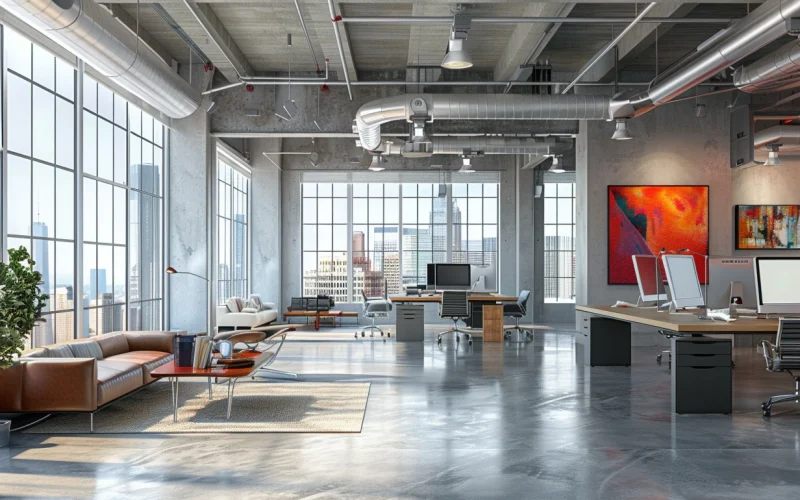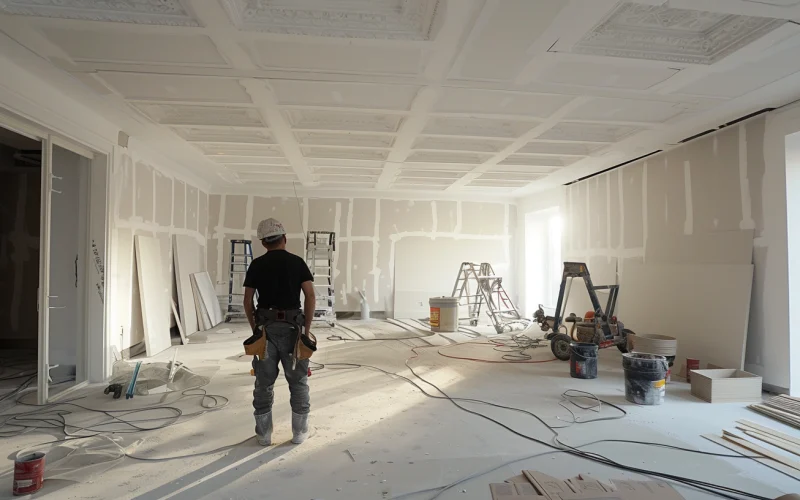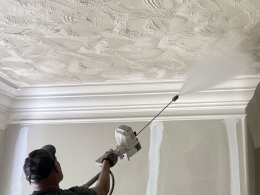Open ceiling concepts have recently gained massive attention in modern office design. They give an industrial, airy aesthetic that can make a workspace feel more expansive.
However, before implementing this design trend, it’s important to consider the potential disadvantages of exposed ceilings carefully.
If you have been considering incorporating something similar to this into your space, it is essential that you do all the checks and balances.
This article aims to do the same for you. Throughout this blog, we will explore the various drawbacks of open ceilings.
This would range from increased expenses, acoustic issues, higher energy costs, and other similar aspects.
The Style and Significance of Open Ceilings
Open ceilings, also known as exposed ceilings, have become a trendy design choice in recent years.
This style involves leaving the ceiling infrastructure, such as ductwork, piping, and electrical installations, exposed and visible.
Open ceilings’ raw, unfinished look contributes to an industrial, modern aesthetic that many businesses find appealing.
The significance of open ceilings extends beyond mere aesthetics. By removing the visual barrier of a suspended ceiling, they can create the illusion of a more spacious and airy work environment.
This can be particularly beneficial for offices with limited square footage or low ceiling heights.
Additionally, open ceilings allow for more creative lighting solutions and can improve the distribution of natural light throughout the space, potentially boosting employee productivity and well-being.
However, while open ceilings offer some benefits, it’s crucial to consider the potential drawbacks before deciding.
Upon careful maneuvering associated with the drawbacks, you can also check our guide on various open ceiling ideas to revamp your space today!
Disadvantages of Going with Open Ceiling Designs
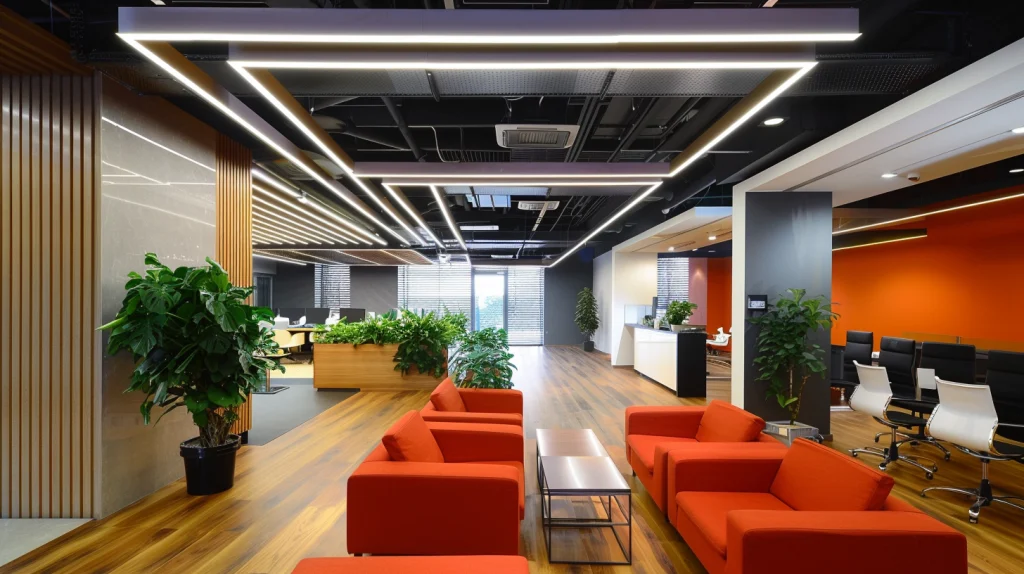
This might sound like a new-age concept to some of you, but it has many drawbacks.
In this section, we will list some of the relevant drawbacks you should consider if you plan to deal with them.
1. Higher Costs
Open ceilings often come with unexpected costs. Ensuring the exposed infrastructure, such as ductwork and plumbing, is visually appealing may require replacement or extensive modifications.
Painting exposed ceilings is also more labor-intensive and demands skilled professionals, driving up expenses.
Additionally, the need for acoustic treatments to address noise issues and the potential for increased energy consumption due to less efficient insulation can further escalate costs.
Businesses must carefully assess their budget and weigh the potential financial impact before opting for an open ceiling design.
2. Noise Problems
Open ceilings can create acoustic challenges in the workplace. Without the sound-absorbing properties of suspended ceilings, noise and echoes can travel freely, leading to a disruptive environment.
The increased sound transmission can make it difficult for employees to concentrate, communicate effectively, or have private conversations.
To mitigate these issues, businesses may need to invest in additional acoustical treatments, such as acoustic panels or suspended baffles, which can add to the overall project cost.
Careful consideration of the workplace’s acoustic needs is essential before choosing an open ceiling design.
3. Increased Energy Costs
Open ceilings can increase businesses’ energy expenses. The exposed structure is less effective at preventing heat transfer, increasing heating and cooling costs.
The additional space created by removing suspended ceilings requires more energy to maintain a comfortable temperature.
This can result in higher utility bills and a larger environmental footprint.
Businesses should assess the potential impact on their energy consumption and costs before deciding on an open ceiling design, especially in regions with extreme temperatures or high energy prices.
4. Maintenance and Cleaning
Maintaining and cleaning open ceilings can be more challenging and costly than suspended ceilings.
The exposed infrastructure, such as ductwork and pipes, requires regular cleaning to prevent dust accumulation and maintain a presentable appearance.
Any leaks, damages, or maintenance issues are immediately visible and must be addressed promptly to avoid disruptions in the workplace.
This can lead to increased maintenance costs and potential downtime.
Businesses should factor in the additional maintenance requirements and associated expenses when considering an open ceiling design for their office space.
5. Lack of Privacy
Open ceilings can negatively impact workplace privacy. Without the sound-dampening properties of suspended ceilings, conversations and noise travel more easily between different office areas.
This can be problematic for businesses dealing with sensitive information or requiring confidentiality.
Employees may feel less comfortable having private discussions or making phone calls in an open-ceiling environment, which can lead to potential breaches of privacy and decreased productivity.
Companies must carefully consider the level of privacy needed in their workspace before opting for an open ceiling design.
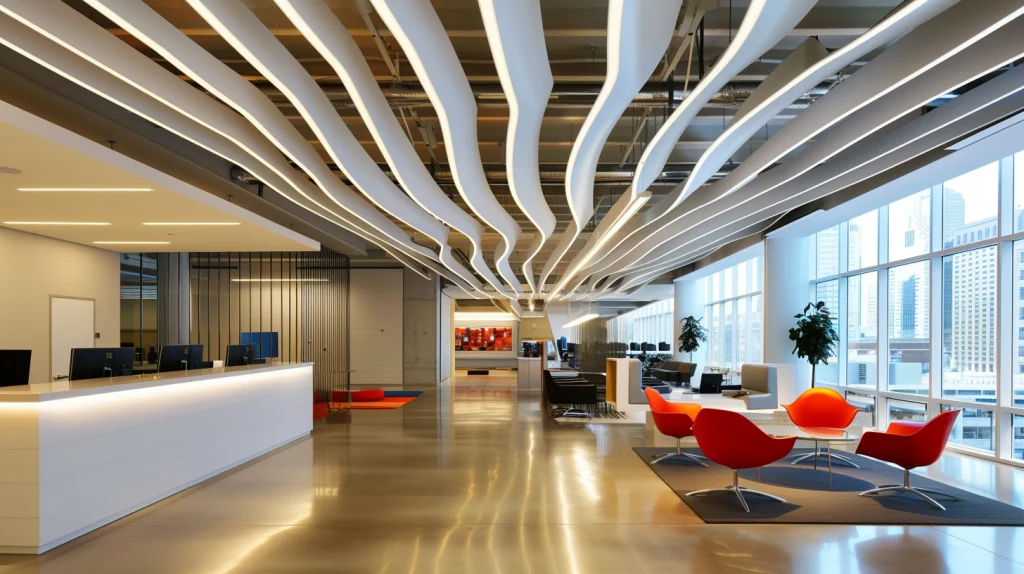
6. Aesthetic Challenges
While open ceilings can provide a trendy, industrial look, they may not suit all businesses or office aesthetics.
Some companies prefer a more traditional or professional appearance, which can be difficult to achieve with exposed ductwork, piping, and electrical installations.
Creating a cohesive and visually appealing design with an open ceiling requires carefully considering and integrating the exposed elements into the overall office aesthetic.
This can be challenging for businesses with specific branding guidelines or those in industries that demand a more polished appearance.
7. Potential Safety Hazards
Exposed ceilings can introduce potential safety hazards in the workplace.
Low-hanging pipes, ductwork, or electrical installations can pose a risk of injury if employees accidentally bump into them.
In the event of a fire, open ceilings can contribute to the rapid spread of flames and smoke, compromising the safety of the building’s occupants.
Additionally, exposed wiring or mechanical systems may be more vulnerable to damage, leading to potential electrical or mechanical failures.
Businesses must prioritize employee safety and consider these risks when deciding on an open ceiling design for their workspace.
Conclusion
While open ceiling concepts can provide a contemporary and fashionable appearance for your office, it’s essential to thoroughly assess the potential drawbacks before committing to this design choice.
Exposed ceilings come with various challenges that businesses must consider, such as increased costs associated with modifications and maintenance, acoustic problems, and potential safety hazards posed by exposed infrastructure.
Before settling on an open ceiling design, carefully evaluate your needs, budget limitations, and aesthetic preferences to ensure this design aligns with your overall workspace requirements.
Consult with design professionals and conduct a thorough cost-benefit analysis to make an informed decision that will benefit your employees and you in the long run.





